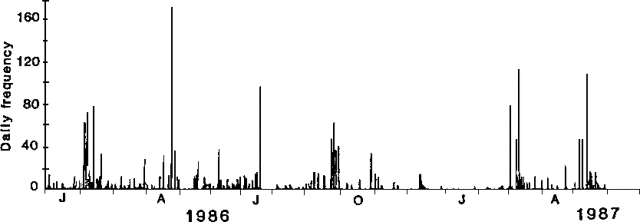Report on Bulusan (Philippines) — May 1987
Scientific Event Alert Network Bulletin, vol. 12, no. 5 (May 1987)
Managing Editor: Lindsay McClelland.
Bulusan (Philippines) Seismic swarm and slightly increased steaming
Please cite this report as:
Global Volcanism Program, 1987. Report on Bulusan (Philippines) (McClelland, L., ed.). Scientific Event Alert Network Bulletin, 12:5. Smithsonian Institution. https://doi.org/10.5479/si.GVP.SEAN198705-273010
Bulusan
Philippines
12.769°N, 124.056°E; summit elev. 1535 m
All times are local (unless otherwise noted)
Seismicity rose again to a high level on 5 May with two high-frequency and 18 low-frequency volcanic earthquakes recorded in the area of the volcano. The beginning of the swarm was accompanied by a slight increase in steam emission at an upper fissure. Five tectonic earthquakes with large maximum double amplitudes were recorded the same day. A total of 103 high-frequency and 308 low-frequency volcanic events were recorded by the 3-station seismic network during the entire crisis. This swarm occurred 55 days after the previous swarm on 3-21 March. A two-month recurrence had been recognized for seismic swarms prior to the May episode (figure 1).
Further Reference. Bautista, L.P., 1987, Volcano Update - Bulusan Volcano: PHIVOLCS Observer, v. 3, no. 2, p. 5.
Geological Summary. Luzon's southernmost volcano, Bulusan, was constructed along the rim of the 11-km-diameter dacitic-to-rhyolitic Irosin caldera, which was formed about 36,000 years ago. It lies at the SE end of the Bicol volcanic arc occupying the peninsula of the same name that forms the elongated SE tip of Luzon. A broad, flat moat is located below the topographically prominent SW rim of Irosin caldera; the NE rim is buried by the andesitic complex. Bulusan is flanked by several other large intracaldera lava domes and cones, including the prominent Mount Jormajan lava dome on the SW flank and Sharp Peak to the NE. The summit is unvegetated and contains a 300-m-wide, 50-m-deep crater. Three small craters are located on the SE flank. Many moderate explosive eruptions have been recorded since the mid-19th century.
Information Contacts: PHIVOLCS.


